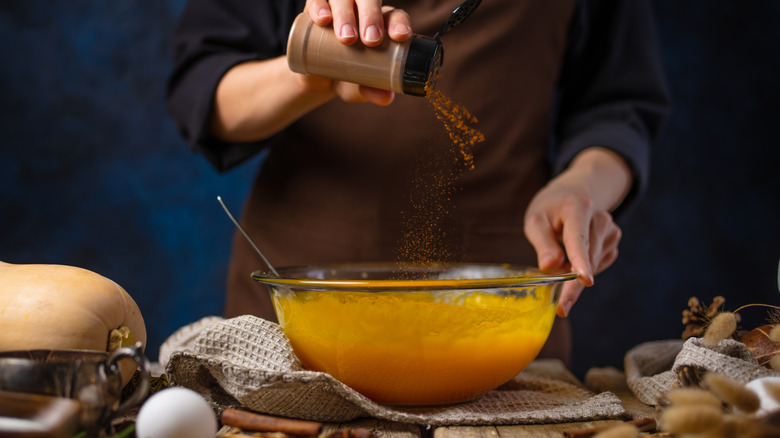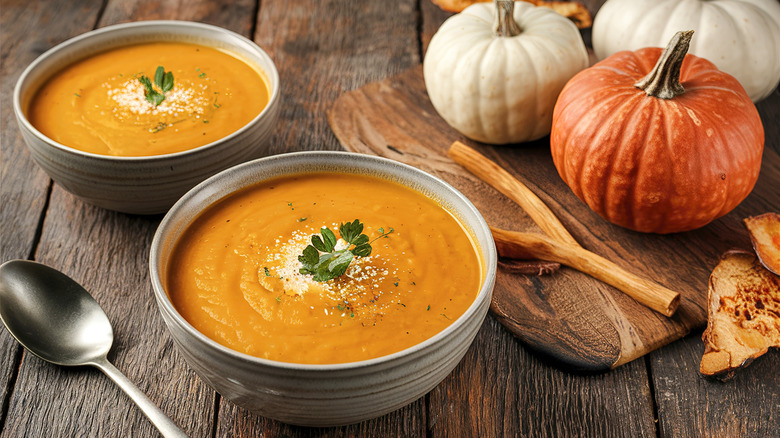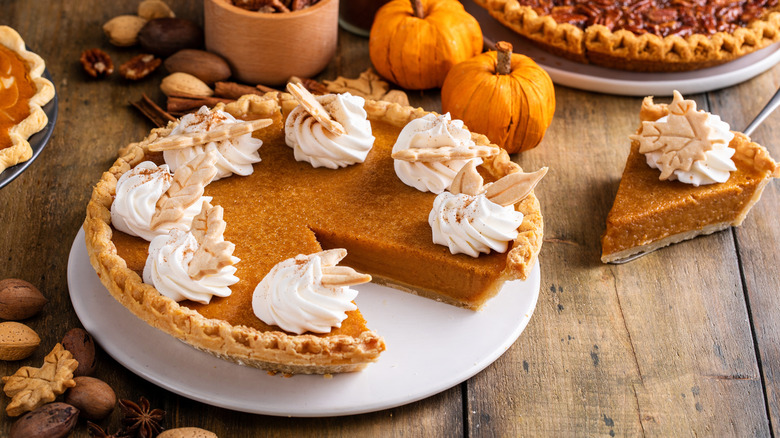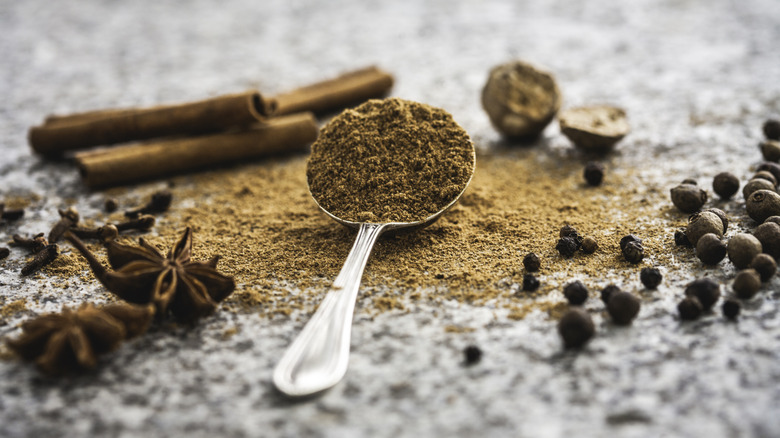Are Pumpkin Purée And Pumpkin Pie Filling Interchangeable?
Pumpkin purée and pumpkin pie filling share many similarities: they're both canned pumpkin products, they're available in similar sizes that cost about the same, and they list pumpkin as their first ingredient. They also both have a role to play in delicious pumpkin desserts and a brand that produces one likely also produces the other. Libby's, the iconic brand famous for both products, even uses a picture of pumpkin pie on both of their purée and pie mix labels. In fact, for two products that are not the same, they might be more similar than they are different.
Still, while there are some techniques to make one taste more like the other if you've picked up the wrong product (more on that later), pumpkin pie filling and pumpkin purée are not interchangeable. Recipes will always call for one or the other specifically, so save yourself the headache and look carefully at the can before purchasing.
Before we break down their differences in detail, the key element to keep in mind as you shop is this: pumpkin purée is exactly, exclusively that. Pumpkin isn't just the first ingredient, it's the only ingredient. Pumpkin pie filling, on the other hand, has added spices and sweeteners. So, when making a homemade pie, for instance, the choice is yours — do you want to season and spice your pumpkin to taste? Or leave it to the industry experts?
Pumpkin purée is purely pumpkin
Pumpkin purée is 100% pumpkin. There's no salt, sugar, sweetener, artificial coloring, or preservatives. Pumpkin purée is widely available in both 15 and 29-ounce cans. Once you crack open the can, you'll first be struck by its bright orange (all natural) color. Pumpkins are cooked and blended to create the purée, so the texture is very smooth — somewhere in between loose tomato sauce and thick tomato paste. Pumpkin purée will smell very vegetal. You might be surprised that it doesn't smell much like a baked good (or like a pumpkin spice latte), but that's because it's missing all those season-signaling spices.
Pumpkin purée tastes like pumpkin, so similar to a mildly sweet squash or an earthy sweet potato. Pumpkin purée is what's called for in all savory pumpkin recipes, like a spiced pumpkin squash soup, a pumpkin cream pasta sauce, or pumpkin ravioli. It's a neutral flavor that's easy to adapt with other spices, alliums, and added salt and its texture makes it easy to incorporate.
For sweet recipes, many chefs still prefer the flexibility of pumpkin purée over pumpkin pie filling. If you love nutmeg but hate cloves, the amount you use in your pie, loaf, or muffins is up to your discretion. If you like your seasonal desserts more strongly flavored with honey or maple syrup, you can cut back on the sugar you add. If you're going to stock your pantry with only one pumpkin product, pumpkin purée is the perfect, more malleable choice.
Pumpkin pie filling features extra sugar and spice
Pumpkin pie filling varies from brand to brand. Libby's Pumpkin Pie Mix, for instance, adds sugar, salt, and "spices," though the flavors of cinnamon, ginger, and cloves are easy to pick out. All pumpkin pie fillings or mixes will add sugar and a little salt, as well as their own mixture of cinnamon, nutmeg, cloves, ginger, mace, or allspice. Libby's sells its pumpkin mix in 30-ounce cans, with the idea that you can combine exactly one can with evaporated milk and eggs for an easy, nostalgic pumpkin pie that can be cooling on the table within an hour.
When you pop open a can of pumpkin pie filling, you'll notice the color is slightly lighter than the purée. You'll also immediately get a whiff of the cinnamon-y, pumpkin spice smell. The texture is very similar to pumpkin purée, but even more smoothly blended with the idea that it's going directly into a pie crust. If you taste pumpkin pie filling straight from the can, it will taste sweet but not overbearingly so. Pumpkin pie filling is perfect when you need to deliver quick results, or when your guests are clamoring for the pumpkin pie they remember from childhood.
What to do when you've bought the wrong one
If your recipe calls from pumpkin pie filling but you've only got purée, you're absolutely golden. All you need to do is add sugar and spices to taste, all of which you'll likely have on hand from other baking projects. If your pumpkin pie recipe also calls for sweetened condensed milk, it's probably sweet enough for most palates, but definitely add cinnamon, nutmeg, and ginger, or a teaspoon or two of pumpkin spice.
Accidentally-acquired pumpkin pie filling will be more difficult to work with in savory recipes, but it is doable. Eschew any other sweeteners that the recipe calls for, then amp up the other flavors to cut through the sugar. More salt, pepper, chili flakes, or lemon juice can do the trick, depending on the recipe. For sweet recipes, dial back some, but not all, of the sugar. Now that you're equipped with this knowledge, stroll boldly down the baking aisle, and choose your pumpkin fighter.



